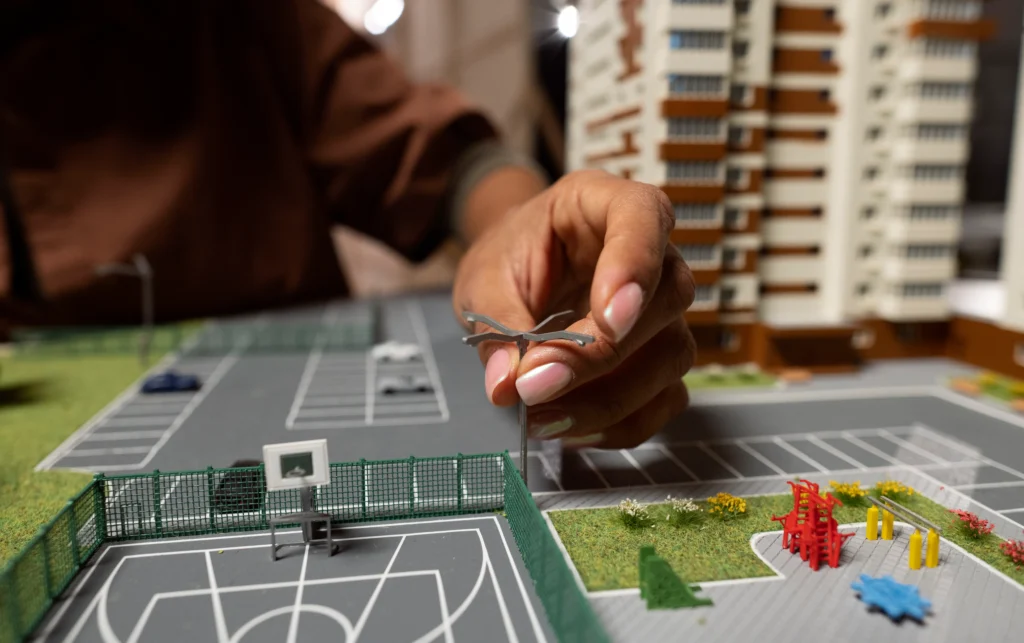3D Floor Plans: Enhancing Property Descriptions and Sales

1. Introduction
The Evolution of Real Estate Marketing
The real estate industry has always been dynamic, adapting to technological changes, market trends, and consumer behavior. One of the most significant shifts in recent years has been how properties are marketed. Gone are the days when a few high-resolution photos and a concise property description sufficed. Today’s buyers are tech-savvy, demanding more immersive and informative experiences when exploring potential homes or investments.
The traditional marketing approach, relying solely on static images and text, often left much to the imagination of prospective buyers. While professional photography played a crucial role, there were limitations to what a flat image could convey. Buyers had to piece together a property’s layout, flow, and potential based on a few pictures and a written description.
The Rise of 3D Floor Plans
Enter 3D floor plans—a revolutionary technology transforming how properties are presented and described. Unlike traditional two-dimensional floor plans, which provide a bird’s-eye view of a property’s layout, 3D floor plans offer a three-dimensional, immersive experience. They bring properties to life, allowing potential buyers to walk through and explore every nook and cranny virtually.
The rise of 3D floor plans directly responds to the changing expectations of buyers and sellers in the real estate market. Sellers seek innovative ways to make their properties stand out, while buyers want more comprehensive information to aid their decision-making process. As a result, 3D floor plans have become a powerful tool in the real estate industry, enhancing property descriptions and ultimately driving sales.
In the following sections, we will dive deeper into what 3D floor plans are, how they differ from traditional floor plans, the technology behind them, and how they transform property descriptions and sales. We will explore their impact on creating immersive property experiences and discuss real-life success stories that showcase their effectiveness. Additionally, we will examine the benefits that 3D floor plans offer to real estate professionals and discuss the future of real estate marketing in the context of this transformative technology.
2. Understanding 3D Floor Plans
What Are 3D Floor Plans?
We must first understand what they are to comprehend the significance of 3D floor plans in enhancing property descriptions and sales. A 3D floor plan is a digital representation of a property’s layout and design created with advanced computer-aided design (CAD) software. Unlike traditional 2D floor plans, which are static and lack depth, 3D floor plans provide a dynamic, immersive experience.
These plans offer a lifelike three-dimensional view of a property, enabling viewers to virtually walk through the space and explore it from various angles. They accurately capture a property’s dimensions, proportions, and spatial relationships, making it easier for potential buyers to visualize the layout and flow.
How Are They Created?
The creation of 3D floor plans involves a combination of architectural expertise and cutting-edge technology. Here’s an overview of the typical process:
- Initial Consultation: The process begins with an initial consultation between the real estate professional and a 3D rendering specialist or architect. During this meeting, the objectives, budget, and timeline are discussed.
- Property Measurement: Accurate measurements of the property are taken. This step is crucial to ensure the 3D floor plan accurately reflects the property’s dimensions.
- Design and Rendering: The 3D rendering specialist or architect creates a detailed digital model of the property using specialized CAD software. This model includes walls, doors, windows, fixtures, and furnishings. Every element is meticulously designed to scale.
- Texturing and Lighting: Textures and materials are applied to surfaces to create a realistic appearance. Virtual lighting is also added to mimic natural or artificial lighting conditions.
- Virtual Tour Integration: In some cases, 3D floor plans are integrated into a virtual tour, allowing potential buyers to navigate the property online. This creates a fully immersive experience.
- Review and Feedback: The real estate professional reviews the 3D floor plan and provides feedback. Revisions are made as necessary to ensure accuracy and meet the client’s expectations.
- Final Delivery: Once approved, the final 3D floor plan is delivered in various formats, including images, videos, and interactive virtual tours.
How They Differ from Traditional Floor Plans
The fundamental difference between 3D and traditional floor plans is their depth and interactivity. Traditional floor plans are two-dimensional representations of a property’s layout, often resembling architectural drawings. They provide a top-down view, showing the arrangement of rooms, walls, and key features. While they serve as a helpful starting point, traditional floor plans can be limited in conveying the true spatial qualities of a property.
In contrast, 3D floor plans offer a more immersive experience. They incorporate depth, allowing viewers to see rooms’ and objects’ height, shape, and proportions. With 3D floor plans, you can virtually “walk” through a property, gaining a better understanding of its layout and flow. This added dimensionality provides a more realistic and engaging representation of the space.
The Technology Behind 3D Floor Plans
The creation of 3D floor plans relies on advanced technology and software. Here are some key technological components:
- Computer-Aided Design (CAD): CAD software forms the 3D floor plan creation foundation. It enables designers to create detailed 3D models of properties, complete with accurate measurements and specifications.
- 3D Modeling: Within CAD software, 3D modeling tools are used to design and construct the digital representation of the property. This involves creating 3D shapes, adding textures, and defining spatial relationships.
- Rendering Engines: Rendering engines transform 3D models into realistic images or videos. They calculate lighting, shadows, reflections, and materials to create a lifelike appearance.
- Virtual Reality (VR): 3D floor plans are sometimes compatible with virtual reality technology. This allows users to explore properties in a fully immersive VR environment, enhancing the interactive experience.
3. Transforming Property Descriptions
Bringing Properties to Life
One of the most significant contributions of 3D floor plans to real estate marketing is their ability to bring properties to life in a way that traditional floor plans cannot. With a 3D floor plan, potential buyers can visualize the property’s layout as if they were physically present. They can virtually step into each room, assess the spatial flow, and gauge how the space will suit their needs.
This dynamic representation eliminates the ambiguity that often accompanies traditional floor plans. It answers questions like, “Is there enough space for a dining table in the kitchen?” or “How does the primary bedroom connect to the ensuite bathroom?” Such details are difficult to discern from 2D plans but become evident and intuitive in 3D.
Enabling Virtual Walkthroughs
One of the most compelling features of 3D floor plans is their capacity to enable virtual walkthroughs. This means potential buyers can navigate a property online as they would during an in-person viewing. They can move from room to room, explore different angles, and get a genuine sense of the property’s layout.
This feature is precious for long-distance buyers who need help visiting the property in person. It saves time and money by allowing them to assess the property’s suitability without needing physical travel. Additionally, it enhances the decision-making process for local buyers who can explore properties conveniently.
Fostering Emotional Connections
Buying a property is not just a rational decision; it’s an emotional one. People need to feel a connection to a space before committing to it. 3D floor plans play a crucial role in fostering these emotional connections. By offering a realistic and immersive experience, potential buyers can imagine themselves living in the property.
Imagine a family considering a new home. With a 3D floor plan, they can virtually walk through the house, see their children’s bedrooms, picture themselves cooking in the kitchen, and envision family gatherings in the living room. This emotional engagement goes beyond what traditional floor plans can achieve. It taps into the aspirational aspect of buying a home—how it will enhance one’s lifestyle and fulfill dreams.
Furthermore, 3D floor plans enable customization and personalization. Buyers can mentally arrange their furniture, choose color schemes, and explore design possibilities. This level of interaction turns passive viewing into active engagement, where the property becomes a canvas for their creativity.
Transparency and Trust
In real estate transactions, transparency and trust are paramount. Buyers want to feel confident that they know exactly what they’re purchasing, and sellers aim to present their properties honestly. 3D floor plans contribute significantly to this trust-building process.
A property listing with a 3D floor plan sends a clear message: “We have nothing to hide.” Potential buyers can scrutinize every property detail, from the layout to the dimensions of rooms. They can identify potential issues or concerns upfront, such as the flow of space or any irregularities.
This transparency helps set realistic expectations. When buyers eventually visit the property in person, they are less likely to be surprised by discrepancies between the 3D floor plan and reality. It minimizes the risk of misunderstandings and fosters a smoother, more confident purchasing process.
4. Enhancing Sales and Marketing
Accelerated Decision-Making
In the fast-paced world of real estate, speed can be a competitive advantage. Properties that linger on the market for extended periods can raise questions and erode buyer confidence. 3D floor plans can expedite the decision-making process for both buyers and sellers.
For buyers, exploring a property through a 3D floor plan saves time. They can conduct initial property assessments online, narrowing down their options efficiently. Instead of visiting numerous properties in person, they can shortlist those that align with their needs and preferences.
Sellers also benefit from faster decision-making. Serious buyers who have explored a 3D floor plan are more likely to schedule in-person viewings. These potential buyers are already familiar with the property’s layout and features, reducing the need for extensive on-site explanations. This can lead to quicker negotiations and, ultimately, a faster sale.
Increased Property Exposure
In the competitive world of real estate, standing out is essential. Properties that capture attention and generate interest are more likely to sell quickly and at favorable prices. 3D floor plans provide a unique and eye-catching way to showcase listings.
3D floor plans attract more views and engagement when integrated into property listings. They serve as a compelling visual hook, drawing potential buyers into the listing. Once viewers explore the 3D floor plan, they spend more time on the listing page, increasing their chances of contacting the seller or agent.
Moreover, properties with 3D floor plans are more shareable on social media and other online platforms. Buyers impressed by a property’s 3D representation will likely share it with their networks. This viral potential extends the property’s reach to a broader audience, increasing exposure and the likelihood of finding the right buyer quickly.
Higher Conversion Rates
The ultimate goal of any real estate listing is to convert potential buyers into actual purchasers. 3D floor plans increase conversion rates by providing an immersive and informative experience.
When potential buyers engage with a 3D floor plan, they are likely to develop a sense of ownership and attachment to the property. This emotional connection can be a powerful driver of action. Buyers who have mentally moved into a property through a 3D floor plan are more inclined to take the following steps: scheduling a viewing, making an offer, or contacting the seller or agent.
Additionally, 3D floor plans reduce the risk of buyer remorse. When buyers feel well-informed about a property’s layout and features, they are more confident in their decision. This confidence translates into a higher likelihood of proceeding with the purchase.
5. A Tool for Real Estate Professionals
Streamlined Communication
In the real estate industry, effective communication is essential. Agents must accurately convey property details to potential buyers, answer inquiries, and facilitate negotiations. 3D floor plans streamline this communication process.
Real estate professionals can use 3D floor plans as a universal language. They transcend language barriers and ensure that property details are clear and accessible to a diverse range of buyers. Agents can simply share the 3D floor plan link or file with clients, allowing them to explore the property at their own pace.
Furthermore, 3D floor plans enable real estate professionals to provide virtual guided tours. During remote consultations, agents can walk clients through the property via a shared 3D floor plan, pointing out key features, discussing layout options, and addressing questions in real time. This level of interactivity enhances the client-agent relationship and builds trust.
Competitive Edge
A technological edge can make a significant difference in a competitive real estate market. Agents and agencies that embrace 3D floor plans gain a competitive advantage. They demonstrate a commitment to innovation and a willingness to leverage technology for the benefit of their clients.
Agents can use 3D floor plans as a marketing differentiator. Listings with 3D floor plans stand out in online searches, attract more attention, and generate higher engagement. This sets a positive tone for the client-agent relationship and increases the likelihood of successful transactions.
Time and Cost Savings
Traditional property viewings can be time-consuming and costly for both agents and clients. Coordinating schedules, traveling to multiple properties, and conducting in-person tours involve significant investments of time and resources. 3D floor plans offer
a solution to these challenges.
For real estate agents, 3D floor plans can reduce the need for physical property showings during the initial stages of the buying process. Instead of arranging multiple in-person viewings, agents can provide potential buyers access to 3D floor plans. This allows buyers to explore properties conveniently, eliminating agents needing to accompany them to every show.
Additionally, 3D floor plans can help identify serious buyers early in the process. Buyers who have thoroughly explored a property through a 3D floor plan and still express interest in scheduling an in-person viewing are likely to be highly motivated. This focus on qualified leads can save agents time and effort, allowing them to allocate their resources more efficiently.
Data-Driven Insights
In the digital age, data is a valuable resource. Real estate professionals can leverage 3D floor plans to gather data-driven buyer behavior and preferences insights. By tracking user interactions with 3D floor plans, agents and agencies can better understand what aspects of a property are most appealing to buyers.
For example, agents can monitor which rooms or features within a property receive the most attention in a 3D floor plan. This data can inform pricing strategies and marketing efforts. If a particular room consistently generates high levels of engagement, it may be highlighted more prominently in property listings and advertising materials.
Furthermore, data from 3D floor plan interactions can help agents tailor their communication with clients. Agents can use insights about clients’ interactions with 3D floor plans to personalize property recommendations and provide more targeted assistance.
6. Overcoming Challenges and Considerations
Accessibility and Technology
While 3D floor plans offer numerous advantages, they also come with considerations. One of the primary considerations is accessibility. To fully benefit from 3D floor plans, potential buyers must have access to the necessary technology, such as a computer or smartphone with internet access.
To address this challenge, real estate professionals can offer alternatives for those with limited access to technology. This might include providing printed brochures with QR codes that link to online 3D floor plans or offering guided virtual tours via video calls.
Cost of Implementation
Implementing 3D floor plans into a real estate marketing strategy involves an initial investment. The cost can vary depending on factors such as property size and complexity. However, viewing this investment as a long-term strategy that can yield significant returns is essential.
Real estate professionals should assess their budgets and weigh the potential benefits of 3D floor plans. Many find that the enhanced marketing capabilities and accelerated sales justify the upfront costs.
Learning Curve
Adopting new technology often requires a learning curve. Real estate professionals and clients alike may need time to become familiar with navigating 3D floor plans effectively. Agents should be prepared to guide and support clients who may be using this technology for the first time.
Privacy and Security
Privacy and security concerns should also be addressed when using 3D floor plans. Agents should ensure that any personal information or sensitive data shared during virtual tours or interactions with 3D floor plans is handled securely and complies with data protection regulations.
7. Conclusion
In conclusion, 3D floor plans have emerged as a transformative tool in the real estate industry, enhancing property descriptions and driving sales. They offer a dynamic, immersive experience that brings properties to life, fosters emotional connections with buyers, and accelerates decision-making.
Real estate professionals can leverage 3D floor plans to gain a competitive edge, streamline communication, save time and resources, and gather valuable data-driven insights. While there are considerations such as accessibility, cost, and a learning curve, the benefits far outweigh the challenges.
As technology advances, 3D floor plans are poised to play an increasingly significant role in real estate marketing. Those who embrace this innovation are likely to thrive in the industry’s evolving landscape, offering clients an engaging and informative way to explore the homes of their dreams.
With 3D floor plans, the future of real estate marketing is not just bright—it’s three-dimensional.

Best Tips and Tricks for Bitcoin Investments

Top Benefits of Hiring Professional Pet Sitting Services for Your Pets

Expert Insights on Improving Productivity and Efficiency

Accelerating drug discovery through the DEL-ML-CS approach

AI in Marketing Is No Longer a Buzzword — It’s the Strategy

Naya Nazimabad Karachi: A Comfortable Community Growing in the Heart of the City

Aspects You Should Prioritise When You Invest in Residential Plots in Bhiwadi

The Value of Professional Guidance: Benefits of a Real Estate Agent in Home Buying












